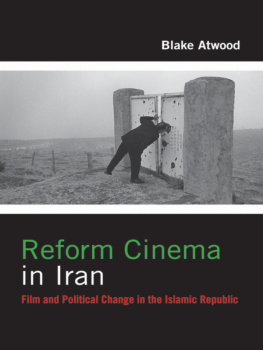Contents
Guide
Pagebreaks of the print version
CINEMA/POLITICS/PHILOSOPHY
FILM AND CULTURE SERIES
FILM AND CULTURE
A SERIES OF COLUMBIA UNIVERSITY PRESS
Edited by John Belton
For a full list of titles in this series, see
CINEMA/POLITICS/PHILOSOPHY

NICO BAUMBACH
Columbia University Press
New York

Columbia University Press
Publishers Since 1893
New York Chichester, West Sussex
cup.columbia.edu
Copyright 2019 Columbia University Press
All rights reserved
E-ISBN 978-0-231-54537-2
Library of Congress Cataloging-in-Publication Data
Names: Baumbach, Nico, author.
Title: Cinema-politics-philosophy / Nico Baumbach.
Description: New York : Columbia University Press, [2019] | Series: Film and culture | Includes bibliographical references and index.
Identifiers: LCCN 2018017877 | ISBN 9780231184229 (hardback ; alk. paper) | ISBN 9780231184236 (trade pbk. ; alk. paper)
Subjects: LCSH: Motion picturesPhilosophy. | Motion picturesPolitical aspects. | Film criticism. | Art and motion pictures.
Classification: LCC PN1995 .B3186 2019 | DDC 791.4301dc23
LC record available at https://lccn.loc.gov/2018017877
A Columbia University Press E-book.
CUP would be pleased to hear about your reading experience with this e-book at .
Cover design: Chang Jae Lee
CONTENTS
W alter Benjamins 1936 essay The Work of Art in the Age of Its Technological Reproducibility advances the following claim: for the first time in history the function of the work of art is political. The evidence: cinema.
These provocative claims get to the heart of the subject of this book. But what allows us to make the connection between cinema, politics, and philosophy? Is cinema just an art or entertainment, or can it be an ethics, a politics, or a form of thought?
Benjamins essay is all too familiar today, but the assumption that cinema cannot be separated from politics, while frequently taken for granted, is not always closely scrutinized. What came to be known as film theory in the American academy, as it took shape in the 1970s, is often seen to share Benjamins emphasis on the intimate connection between cinema and politics. But a subtle reversal had taken place. Film theory was understood to be a political project, but cinemas politics, it was implicitly assumed, tended to be obscured by ideology. The political dimension of cinema could be wrested away from ideology by theory. Theory was entrusted with the power to isolate and demonstrate the politics of films.
We can see this clearly in Cinma/Idologie/Critique (Cinema/Ideology/Criticism), Jean-Louis Comolli and Jean Narbonis highly influential 1969 editorial statement for the newly politicized Cahiers du Cinma . Every film is political, Comolli and Narboni claimed, in what might be taken as an axiom of 1970s film theory. In the wake of the upheavals of May 68, the great French cinephile magazine, cofounded by Andr Bazin in 1951 and once known for its passionate, impressionistic celebrations of filmmakers working within the Hollywood system, now framed film criticisms mission as guided by the rigorous and systematic analysis of any films location within capitalist ideology. This position would help set the agenda for the emerging discipline of Anglo-American film studies over the following decade.
But when Benjamin claims that cinema is political, he means that it has a revolutionary social function. Comolli and Narboni used political to mean ideological. Every film is political, they argued, inasmuch as it is determined by the given ideology which produces it.
Christian Metz provided a succinct description of the basic operation of film theory at this time: to disengage the cinema-object from the imaginary and win it for the symbolic. that is, not with the imaginary but the symbolic.
The assumption that the goal of cinema studies is to wrest the political (understood as the symbolic) from individual films continued in modified form in the cultural studies that became pervasive in film studies in the 1980s. While less suspicious of the pleasures afforded by mainstream films and frequently more ambivalent toward Marxist, psychoanalytic, or structuralist theories, cultural studies approaches still invariably proceeded from a commitment to a critical or resistant position in relation to dominant ideology. Despite its significant differences, in this specific sense, at least, it continued the legacy of seventies film theory.
But today this position has come to be viewed with suspicion, and from the nineties into the first decade of the twenty-first century, numerous books and articles have reevaluated this tradition of film theory as problematic and dated, if not faddish, obscurantist, and incoherent.
Despite the agreement that recent decades have seen a historical turn in film studies, there is little consensus about what theoretical approaches are currently central to the field. All too often, the AntiGrand Theory position might better be understood as Grand Anti-Theory, because it reenacts the very move it criticizes by lumping a wide range of material into a single monolithic category that, once rendered in caricatural terms, can be easily demonstrated to be worthless. But it would be unfair to conflate this totalizing dismissal of Theory with more nuanced critiques that sought to shake off the most sterile tendencies of academic theoretical doxa in favor of new avenues of thinking about film form and history.
The era of anti-theory has subsided because consensus seems to accept that the anti-theorists have won. While the Post-Theory volume may not have inaugurated a new dominant paradigm in American film studies, and indeed this would have gone against its stated intentions, it can, at the very least, be seen as marking a turn that was already in place toward more modest and circumscribed scholarly ambitions within the academic study of film. And the piecemeal approach could be used to characterize the work of many scholars who may not share the same antipathy to psychoanalysis and Marxism as the books contributors. Bordwells own pursuit of formal and stylistic histories provides one example of a not-always-explicitly cognitivist piecemeal approach, as do the growing body of writings on cinema from the perspective of analytic philosophy or ordinary language philosophy, as well as more empirically based histories focusing on regional and/or national cinemas, early cinema, and so on. Since interpretive work and historical scholarship cannot so easily do without theory (as Bordwell and Carroll would agree), we have also witnessed various returns to interesting, and not so interesting, avenues of the history of film theory that may have been forgotten about or dismissed in its Althusserian-Lacanian phasewhether phenomenology; questions of bodies and embodiment, aesthetics and beauty, or ethics and morality; or the theories of Henri Bergson, Jean Epstein, or Andr Bazin.
Yet the renewed interest in classical film theory in recent decades points not only toward a more historical, piecemeal approach to theory, but also in an opposite directiontoward an ontological or metaphysical turn that has been taken up by new forms of film and media philosophy. In the seventies there was an attempt to develop a rigorous theory of cinematic signification that displaced many of the central concerns of classical film theory, especially the question of what makes film an art. At the same time, the emphasis on the relation between form and politics meant a renewed interest in early twentieth-century political aesthetics, in Benjamin and Bertolt Brecht and the theories of Soviet filmmakers, especially Sergei Eisenstein and Dziga Vertov. Today, the interest in classical film theory is less likely to focus on the relation between aesthetics and politics. Yet we should not see the new interest in classical film theory as a victory only for piecemeal theories and sober, empiricist scholarship. Classical film theory has also been summoned to buttress a renewed fascination with cinema as a form of thought and an experience of being.














